Pterophyllum "scalare"
Angelfish
Classification
Cichlidae. Subfamily: Cichlasomatinae
Distribution
The natural range of this species covers parts of Colombia, Guyana, Suriname, French Guiana, Peru and Brazil. It’s found in numerous river systems, including the Rio Oyapock, Rio Essequibo, Rio Ucayali, Rio Solimões and the main Amazon drainage. It also occurs in various rivers in the Brazilian state of Amapá. Wild fish are rare in the hobby these days though, with the vast majority of the ones on sale being mass-produced in the Far East and Eastern Europe.
Habitat
The natural range of this species covers parts of Colombia, Guyana, Suriname, French Guiana, Peru and Brazil. It’s found in numerous river systems, including the Rio Oyapock, Rio Essequibo, Rio Ucayali, Rio Solimões and the main Amazon drainage. It also occurs in various rivers in the Brazilian state of Amapá. Wild fish are rare in the hobby these days though, with the vast majority of the ones on sale being mass-produced in the Far East and Eastern Europe.
Maximum Standard Length
6″ (15cm) body length and as much as 8″ (20cm) or more in height.
Aquarium SizeTop ↑
An aquarium measuring 100 ∗ 40 ∗ 50 cm should be the smallest considered.
Maintenance
Well planted with tall leafy plants such as Amazon Swords. Gentle water flow preferred. A tall tank of at least 50 cm is recommended for adult fish.
Water Conditions
Temperature: 76 to 86°f (24 to 30°c)
pH: 6.0 – 7.4
Hardness: 0-15 dH
Diet
Omnivorous but wild fish feed predominantly on various items of zoobenthos such as small crustaceans and other aquatic invertebrates. today’s tank-bred fish are far-removed from their ancestors Will accept pellet or flake food in the aquarium. Relishes live or frozen foods.
Behaviour and CompatibilityTop ↑
Generally a peaceful cichild but may squabble with it’s own kind, so best kept in small groups. Good community fish but may eat small fish such as tetras.
Sexual Dimorphism
Quite difficult to sex. Males have smaller, pointed genital papillae but this can only usually be seen when spawning. Behaviour may be a better indicator as males are likely to be more aggressive and territorial especially when inbreeding condition. If you are intending breeding, it is a good idead to start with a group of six juvenile fish. From this a pair is sure to form.
Reproduction
Angels spawn on vertical surfaces such as slate, broad-leaved plants or even the aquarium glass. If you have a bonded pair, little needs to be done to ecourage them to breed. Ensure the fish are well conditioned with live food such as bloodworm and brineshrimp. Angels make good parents and will guard the eggs and then the fry, once hatched. Ensure the adults are kept well fed as it is not unkown for them to eat their fry. Fry can be fed with newly hatched brine shrimp after they have absorbed their yolk sacs (usually after two days) and then moved on to commercially available fry food.
NotesTop ↑
A well known and popular aquarium fish. Angels are available in a number of colour forms including black, gold and koi strains, in addition to the standard silver. It is worth remembering that although angels are generally peaceful, they are still cichilds so some aggression should be expected from time to time.

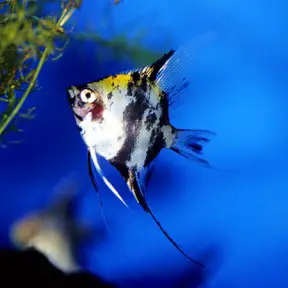
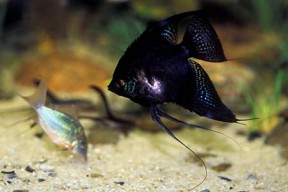
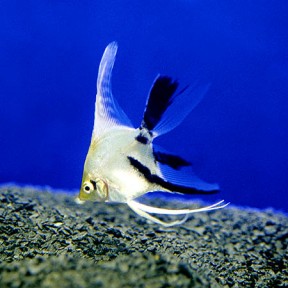
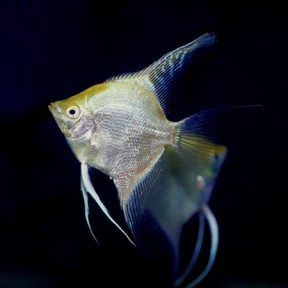

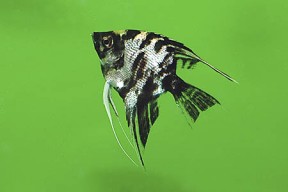
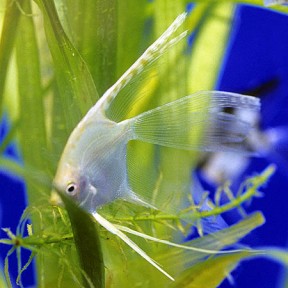

December 26th, 2012 at 11:01 pm
Sugested tank dimensions are a really bad joke. Anything smaller than 100x40x50 is to small. It’s outrageous, or even next to ignorant, to suggest that adult P. scalare could be housed in such a small aquarium. I’ve seen hundreds of P. scalare and I assure you, that this fish can outgrow these dimensions easily.
Adult ‘Manacapuru’ can grow up to 27 cm high, and it needs some place to manoeuvre when the second of pair fish is in the nearest vicinity, hence, no matter if there are 1 or 2 pairs in aquarium, it should allow the fish to move freely.
December 30th, 2012 at 12:59 pm
Thanks for the feedback, I’ve made an alteration based on you recommendations. Not a bad joke nor ignorance though. This is simply one of many profiles that were written a number of years ago and remain in need of editing.
December 31st, 2012 at 10:37 am
I’m sorry for an outburst, but I had a really bad day. After seeing eleven questions about “What to do with my P.scalare in my 112 l tank, when I saw this in a long awaited article on SF.
Nevertheless. I am happy that the info is rewritten, and now is correct.
I also think, that there should be info in notes, that although there are many colour variations, it is advised not to breed P. scalare of different colour forms, which is especially important with harder to get wild forms, such as ‘Manacapuru’, ‘Peru’ etc.
Also P. scalare benefits from vertically oriented treeroots which are used to hide and to spawn (instead of spawning cones). They also like the addition of living roots of plants such as Scyndapsus aureus, or other vines that use aqurium as a hydroponic setup.
Last but not least, P.scalare should be allowed to hide in the darkness when stressed, so dimm lighting, or coverege of floating plants (or vines) is advised.
January 6th, 2013 at 11:31 pm
I bred P. scalare for many years. 30 gal US tall is best for pairs. Use the old fashioned slate piece at 45 degrees and some potted plants for cover. Bare bottom. Sverting is correct about the vertical roots or equivalent and dim light. I used to use simple room/natural light for the scalare breeding room.
January 7th, 2013 at 8:06 am
Thanks guys, will give this a full update asap and include all these suggestions. Am a bit preoccupied with loaches at the minute. 🙂
January 7th, 2013 at 11:35 am
30 gal is ok for breeding, but for long term keeping it should be bigger, unless you accept dwarfing (not sure if it’s a correct term in english) of adult forms.
Of course there is fundamental diffence between US and European way of keeping fihs, we all know that and I don’t want to discuss which is the correct one, but at least in Poland we use the 200liters aquarium as the smallest for a pair. 12″ high aquarium (~30cm) is not high enough, and if it is 12″ in width, than it is hard for fish tomove around each other. If jdrowe30 has such an aquarium for longer term, than it isn’t with benefit to the P. scalare.
http://i45.tinypic.com/2ekn4ug.jpg
This photo should make my point.